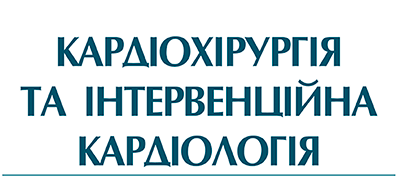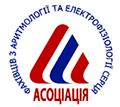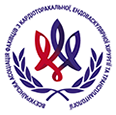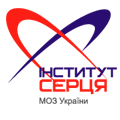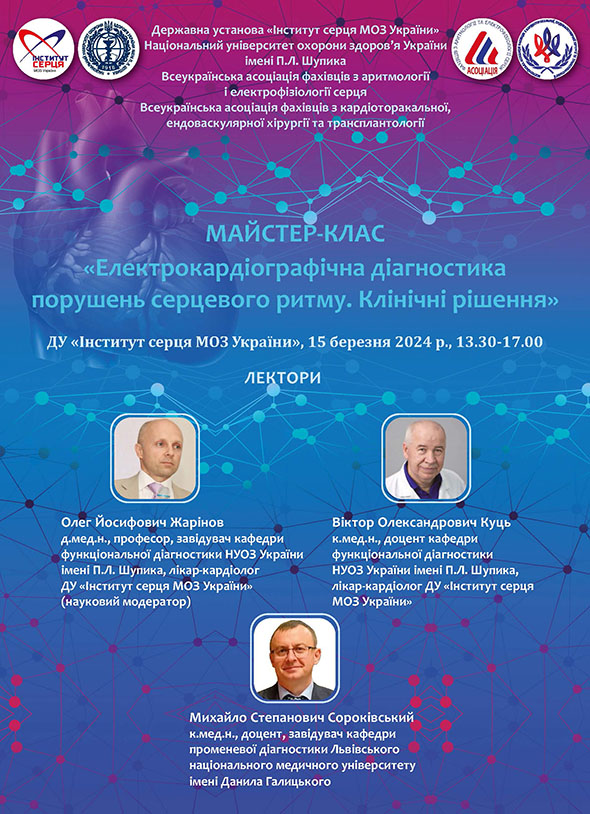Пошкодження міокарда в умовах кардіоплегії та штучного кровообігу
М.Т. Ватутін, Г.Г. Тарадiн, А.О. Тараторіна, Є.В. Єщенко, В.С. Колесніков
Література
1. Bokeria LA, Avaliani VM, Merzlyakov VYu. Aortocoronary bypass surgery on a working heart. Moskva, 2008. 490 p. (in Rus.).
2. Merzlyakov VYu, Selimyan LS. Evaluation and prognostic value of myocardial damage in open heart surgery. RAMS. 2012;13(3):19-26. (in Rus.).
3. Alpert JS, Thygesen K, Antman E, Bassand J.P. Myocardial infarction redefined - a consensus document of The Joint European Society of Cardiology/American College of Cardiology Committee for the redefinition of myocardial infarction. J Am Coll Cardiol. 2000;36:959-969.
4. Andrews DT, Sutherland J, Dawson P, et al. L-arginine cardioplegia reduces oxidative stress and preserves diastolic function in patients with low ejection fraction undergoing coronary artery surgery. Anaesth. Intensive Care. 2012;40:99-106.
5. Bae YS, Kim Y, Kim JH, et al. Independent functioning of cytosolic phospholipase A2 and phospholipase D1 in Trp-Lys-Tyr-Met-Val-D-Metinduced superoxide generation in human monocytes. J Immunology. 2000;164(8):4089-4096.
6. Bein B, Renner J, Caliebe D, et al. Sevoflurane but not propofol preserves myocardial function during minimally invasive direct coronary artery bypass surgery. Anesth Analg. 2005;100(3):610-616.
7. Brener SJ, Lytle BW, Schneider JP, et al. Association between CK-MB elevation after percutaneous or surgical revascularization and three-year mortality. J Am Coll Cardiol. 2002;40:1961-1967.
8. Bull DA, Maurer J. Aprotinin and preservation of myocardial function after ischemia-reperfusion injury. Ann Thorac Surg. 2003;75:735-739.
9. Cagli K, Ozbakir C, Ergun K, et al. Electrocardiographic changes after coronary artery surgery. Asian. Cardiovasc. Thorac. Ann. 2006;14:294-299.
10. Caimmi PP, Kapetanakis EI, Beggino C, et al. Management of acute cardiac failure by intracoronary administration of levosimendan. J. Cardiovasc. Pharmacol. 2011;58:246-253.
11. Caimmi PP, Molinari C, Uberti F, et al. Intracoronary levosimendan prevents myocardial ischemic damages and activates survival signaling through ATPN-sensitive potassium channel ad nitric oxide. Eur. J. Cardiothorac. Surg. 2011;39:59-67.
12. Careaga G, Salazar D, Tellez S, et al. Clinical impact of histidine-ketoglutarate-tryptophan (HTK) cadioplegic solutionon the perioperative period in open heart surgery subjects. Arch. Med. Red. 2001;32:296-299.
13. Carter JM, Buerke U, Rossner E, et al. Anti-inflammatory actions of aprotinin provide dose-dependent cardioprotection from reperfusion injury. Brit J Pharmacol. 2008;155:93-102.
14. Chandrasekar B, Mitchell DH, Colston JT, Freeman GL. Regulation of CCAAT/Enhancer binding protein, interleukin-6, interleukin-6 receptor, and gp130 expression during myocardial ischaemia/reperfusion. Circulation. 1999;99(3):427-433.
15. Chikwe J, Bedow E, Glenville B. Oxford Specialist Handbooks in Surgery - Cardiothoracic Surgery. Oxford University Press, 2006. 832 p.
16. Christen S, Finckh B, Lykkesfeldt J, et al. Oxidative stress precedes peak systemic inflammatory response in pediatric patients undergoing cardiopulmonary bypass operation. Free Radic. Biol. Med. 2005;38(10):1323-1332.
17. De Bruyn H, Gelders F, Gregoir T, et al. Myocardial Protection during Cardiac Surgery: Warm Blood versus Crystalloid Cardioplegiа. World J Cardiovasc Diseases. 2014;4:422-431.
18. De Hert SG, ten Broecke PW, Mertens E, et al. Sevoflurane but not propofol preserves myocardial function in coronary surgery patients. Anesthesiology. 2002;97(1):42-49.
19. Deten A, Volz HC, Holzl A, et al. Effect of propranolol on cardiac cytokine expression after myocardial infarction in rats. Mol Cell Biochem. 2003;251(1-2):127-137.
20. Dreyer WJ, Phillips SC, Lindsey ML, et al. Interleukin 6 induction in the canine myocardium after cardiopulmonary bypass. J Thorac Cardiovasc Surg. 2000;120(2):256-263.
21. Du Toit EF, Muller CA, McCarthy J, Opie L.H. Levosimendan: effects of a calcium sensitizer on function and arrhythmias and cyclic nucleotide levels during ischemia/reperfusion in the Langendorff-perfused guinea pig heart. J Pharmacol Exp Ther. 1999;290:505-514.
22. El-Morsy GZ, Abdullah HM, Abo-Haded HM. Does type of cardioplegia affect myocardial and cerebral outcome in pediatric open cardiac surgeries? Ain-Shams J Anesthesiology. 2014;7:242-249.
23. Falahati A, Sharkey S, Christensen D. Implementation of serum cardiac troponin I as marker for detection of acute myocardial infarction. Am Heart J. 1999;137:332-337.
24. Fellahi JL, Gue X, Richomme X, et al. Short- and long term prognostic value of postoperative cardiac troponin I concentration in patients undergoing coronary artery bypass grafting. Anesthesiology. 2003;99:270-274.
25. Forde RC, Fitzgerald DJ. Reactive oxygen species and platelet activation in reperfusion injury. Circulation. 1997;95(4):787-789.
26. Freyholdt T, Massoudy P, Zahler S, et al. Beneficial effect of sodium nitroprusside after coronary artery bypass surgery: pump function correlates inversely with cardiac release of proinflammatory cytokines. J Cardiovasc Pharmacoly. 2003;42(3):372-378.
27. Galinanes M. In search of a reliable marker of tissue injury during heart surgery. Heart. 1998;80:317-318.
28. Gaudino M, Pragliola C, Anselmi A, et al. Randomized trial of HTK versus warm blood cardioplegia for right ventricular protection in mitral surgery. Scand Cardiovasc J. 2013;47(6):359-367.
29. Giordano P, Scrascia G, D’Agostino D, et al. Myocardial Damage Following Cardiac Surgery: Comparison between Single-Dose Celsior Cardioplegic Solution and Cold Blood Multi-Dose Cardioplegia. Perfusion. 2013;28:496-502.
30. Grossini E, Caimmi PP, Platini F, et al. Modulation of programmed forms of cell death by intraconary levosimendan during regional myocardial ischemia in anesthetized pigs. Cardiovasc Drugs Ther. 2010;4:5-15.
31. Guru V, Omura J, Alghamdi AA, et al. Is Blood Superior to Crystalloid Cardioplegia? A Meta-Analysis of Randomized Clinical Trials. Circulation. 2006;114:330-338.
32. Halestrap AP, Kerr PM, Javadov S, Woodfield KY. Elucidating the molecular mechanism of the permeability transition pore and its role in reperfusion injury of the heart. Biochim Biophys Acta. 1998;1366(1-2):79-94.
33. Halestrap AP. Mitochondria and reperfusion injury of the heart - a holey death but not beyond salvation. J Bioenerg Biomembr. 2009;41(2):113-121.
34. Halestrap AP, Pasdois P. The role of the mitochondrial permeability transition pore in heart disease. Biochim Biophys Acta. 2009;1787(11):1402-1415.
35. Kato R, Foëx P. Myocardial protection by anesthetic agents against ischemia-reperfusion injury: an update for anesthesiologists. Can J Anaesth. 2002;49(8):777-791.
36. Kevin LG, Novalija E, Stowe DF. Reactive oxygen species as mediators of cardiac injury and protection: the relevance to anesthesia practice. Anesth Analg. 2005;101(5):1275-1287.
37. Khan TA, Bianchi C, Voisine P, et al. Reduction of myocardial reperfusion injury by aprotinin after regional ischemia and cardioplegic arrest. J Thorac Cardiovasc Surg. 2004;128:602-608.
38. Kim KB, Lim C, Lee C, et al. Off-pump coronary artery bypass may decrease the patency of saphenous vein grafts. Ann Thorac Surg. 2001;72:1033-1037.
39. Kokita N, Hara A. Propofol attenuates hydrogen peroxide-induced mechanical and metabolic derangeme rat heart. Anesthesiology. 1996;84(1):117-127.
40. Kokita N, Hara A, Abiko Y, et al. Propofol improves functional and met in ischemic reperfused isolated rat hearts. Anesth Analg. 1998;86(2):252-258.
41. Kuhn EW, Choi YH, Pyun JM, et al. Endothelial Injury Associated with Cold or Warm Blood Cardioplegia during Coronary Artery Bypass Graft Surgery. BioMed Research International. 2015;2015.
42. Lahtinen P, Pitkänen O, Pölönen P, et al. Levosimendan reduces heart failure after cardiac surgery: A prospective, randomized, placebo controlled trial. Crit Care Med. 2011;39:2263-2270.
43. Lehmann LE, Schroeder S, Hartmann W, et al. A single nucleotide polymorphism of macrophage migration inhibitory factor is related to inflammatory response in coronary bypass surgery using cardiopulmonary bypass. Eur J Cardiothorac Surg. 2006;30(1):59-63.
44. Lehrke S, Steen H, Sievers HH, et al. Cardiac troponin T for prediction of short- and long-term morbidity and mortality after elective open heart surgery. Clin Chem. 2004;50:1560-1567.
45. Li YC, Ridefelt P, Wiklund L, Bjerneroth G. Propofol induces a lowering of free cytosolic calcium in myocardial cells. Acta Anaesthesiol Scand. 1997;41(5):633-638.
46. Mojcik CF, Levy JH. Aprotinin and the systemic inflammatory response after cardiopulmonary bypass. Ann Thorac Surg. 2001;71:745-754.
47. Multicenter Study of Perioperative Ischemia (MCSPI) Research Group Effects of acadesine on the incidence of myocardial infarction and adverse cardiac outcomes after coronary artery bypass graft surgery. Anesthesiology. 1995;83:658-673.
48. Murphy PG, Bennett JR, Myers DS, et al. The effect of propofol anaesthesia on free radical-induced lipid peroxidation in rat liver microsomes. Eur J Anaesthesiol. 1993;10(4):261-266.
49. Plummer ZE, Baos S, Rogers CA, et al. The Effects of Propofol Cardioplegia on Blood and Myocardial Biomarkers of Stress and Injury in Patients With Isolated Coronary Artery Bypass Grafting or Aortic Valve Replacement Using Cardiopulmonary Bypass: Protocol for a Single-Center Randomized Controlled Trial. JMIR Res. Protoc. 2014;3:1-10.
50. Raja SG, Dreyfus GD. Modulation of systemic inflammatory response after cardiac surgery. Asian. Cardiovasc Thorac Ann. 2005;13(4):382-395.
51. Rastan AJ, Bittner HB, Gummert JF, et al. On-pump beating heart versus off-pump coronary artery bypass surgery-evidence of pump-induced myocardial injury. Eur J Cardiothorac Surg. 2005;27:1057-1064.
52. Rauen U, Kerkweg U, De Groot H. Iron-dependent vs. iron-independent cold-induced injury to cultured rat hepatocytes: a comparative study in physiological media and organ preservation solutions. Cryobiology. 2007;54:77-86.
53. Rauen U, Klempt S, De Groot H. Histidine-induced injury to cultured liver cells, effects of histidine derivatives and of iron chelators. Cell Mol Life Sci. 2007;64:192-205.
54. Ren G, Dewald O, Frangogiannis N.G. Inflammatory mechanisms in myocardial infarction. Curr Drug Targets Inflamm. Allergy. 2003;2(3):242-256.
55. Riess ML, Stowe DF, Warltier DC. Cardiac pharmacological preconditioning with volatile anesthetics: from bench to bedside? Am J Physiol Heart Circ Physiol. 2004;286(5):1603-1607.
56. Sá MP, Rueda FG, Ferraz PE, et al. Is There Any Difference between Blood and Crystalloid Cardioplegia for Myocardial Protection during Cardiac Surgery? A Meta-Analysis of 5576 Patients from 36 Randomized Trials. Perfusion. 2012;27:535-546.
57. Saini HK, Dhalla NS. Defective calcium handling in cardiomyocytes isolated from hearts subjected to ischaemia-reperfusion. Am J Physiol Heart Circ Physiol. 2005;288(5):2260-2270.
58. Saini-Chohan HK, Dhalla NS. Ca2+ in cardiomyocytes from hearts treated with N-acetylcysteine and N-mercaptopropionylglycine. Can J Physiol Pharmacol. 2009;87(12):1110-1119.
59. Scrascia G, Guida P, Rotunno C, et al. Myocardial protection during aortic surgery: comparison between Bretschneider-HTK and cold blood cardioplegia. Perfusion. 2011;26:427-433.
60. Soos P, Andrasi T, Buhmann V, et al. Myocardial protection after systemic application of L-arginine during reperfusion. J Cardiovasc Pharmacol. 2004;43:782-788.
61. Suleiman MS, Halestrap AP, Griffiths EJ. Mitochondria: a target for myocardial protection. Pharmacol Ther Jan. 2001;89(1):29-46.
62. Suleiman MS, Hancock M, Shukla R, et al. Cardioplegic strategies to protect the hypertrophic heart during cardiac surgery. Perfusion. 2011;26:48-56.
63. Suleiman MS, Zacharowski K, Angelini GD. Inflammatory response and cardioprotection during open-heart surgery: the importance of anaesthetics. Br J Pharmacol. 2008;153(1):21-33.
64. Sztark F, Ichas F, Ouhabi R, et al. Effects of the anaesthetic propofol on the calcium-induced permeability transition of rat heart mitochondria: direct pore inhibition and shift of the gating potential. FEBS Lett. 1995;368(1):101-104.
65. Tasouli A, Papadopoulus K, Antoniu T, et al. Efficacy and safety of perioperative infusion of levosimendan in patients with compromised cardiac function undergoing open heart surgery: importance of early use. Eur J Cardiothoracic. Surg. 2007;32:629-633.
66. Tritapepe L, De Santis V, Vitale D, et al. Levosimendan pre-treatment improves outcomes in patients undergoing coronary artery bypass graft surgery. Brit J Anaesthesia. 2009;102(2):198-204.
67. Venugopal V, Hausenloy DJ, Ludman A, et al. Remote ischaemic preconditioning reduces myocardial injury in patients undergoing cardiac surgery with cold-blood cardioplegia: a randomised controlled trial. Heart. 2009;95:1567-1571.
68. Veres G, Radovits T, Merkely B, et al. Custodiol-N, the novel cardioplegic solution reduces ischemia/reperfusion injury after cardiopulmonary bypass. J Cardiothoracic Surgery. 2015;10:1-7.
69. Vinten-Johansen J. Involvement of neutrophils in the pathogenesis of lethal myocardial reperfusion injury. Cardiovasc Res. 2004;61(3):481-497.
70. Wang M, Baker L, Tsai BM, et al. Sex differences in the myocardial inflammatory response to ischaemia-reperfusion injury. Amer J Physiol Endocrinol Metab. 2005;288(2):321-326.
71. Yamamoto H, Magishi K, Goh K, et al. Cardioprotective Effects of Normothermic Reperfusion with Oxygenated Potassium Cardioplegia: A Possible Mechanism. Interactive Cardiovascular Thoracic Surgery. 2009;9:598-604.
72. Yang Q, He GW. Effect of cardioplegic and organ preservation solutions and their components on coronary endothelium-derived relaxing factor. Ann Thorac Surg. 2005;80:757-767.
| [PDF] | [Зміст журналу] |
